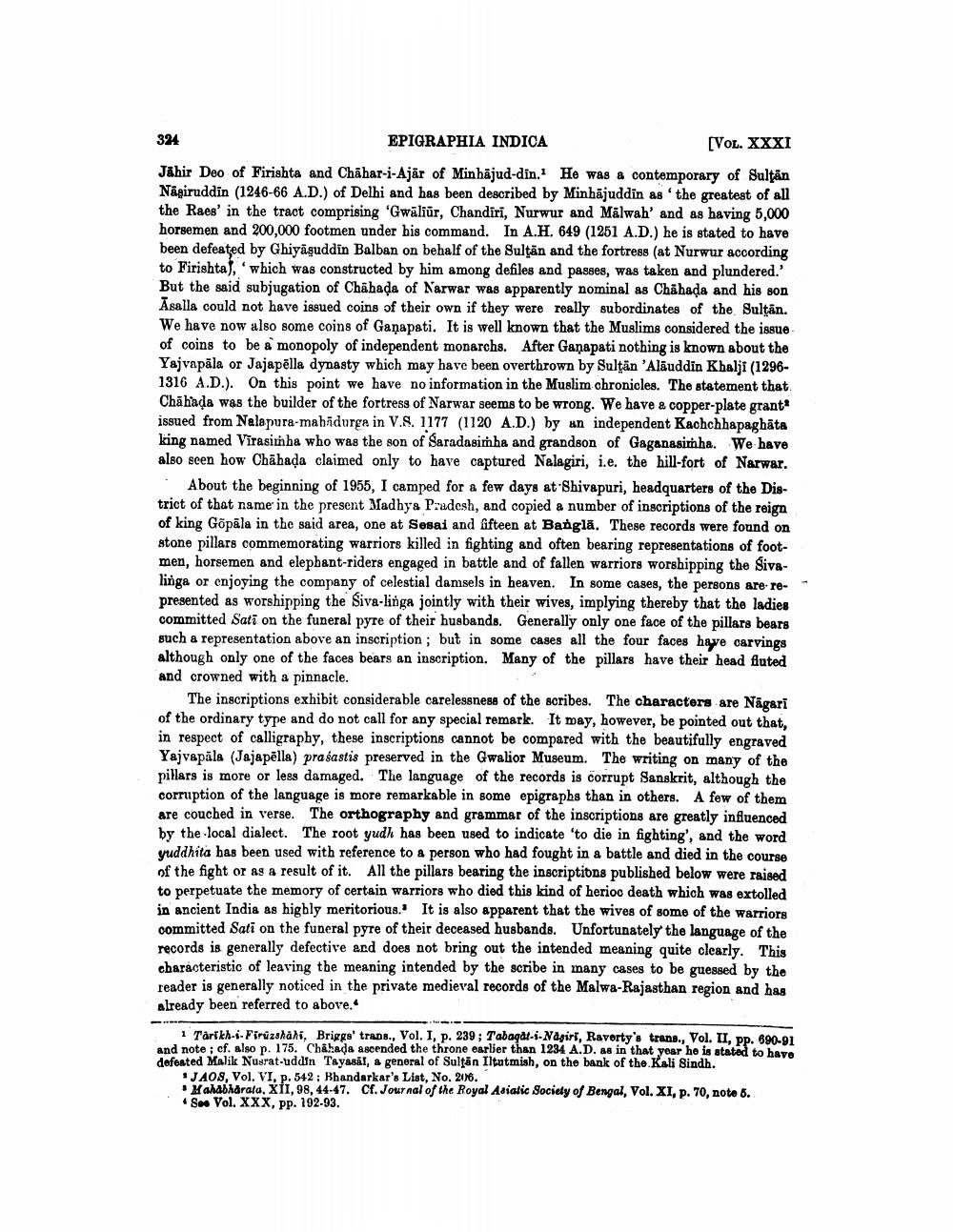________________
324
EPIGRAPHIA INDICA
[VOL. XXXI
Jähir Deo of Firishta and Chahar-i-Ajär of Minhajud-din. He was a contemporary of Sultan Napiruddin (1246-66 A.D.) of Delhi and has been described by Minhajuddin as the greatest of all the Raes' in the tract comprising 'Gwaliūr, Chandiri, Nurwur and Mälwah' and as having 5,000 horsemen and 200,000 footmen under bis command. In A.H. 649 (1251 A.D.) he is stated to have been defeated by Ghiyāguddin Balban on behalf of the Sulţān and the fortress (at Nurwur according to Firishtal, which was constructed by him among defiles and passes, was taken and plundered.' But the said subjugation of Chahada of Narwar was apparently nominal as Chahada and his son Asalla could not have issued coins of their own if they were really subordinates of the Sultan. We have now also some coins of Ganapati. It is well known that the Muslims considered the issue of coins to be a monopoly of independent monarchs. After Ganapati nothing is known about the Yajvapāla or Jajapēlla dynasty which may have been overthrown by Sultan 'Alāuddin Khalji (12961316 A.D.). On this point we have no information in the Muslim chronicles. The statement that Chāhada was the builder of the fortress of Narwar seems to be wrong. We have a copper-plate grant issued from Nalapura-mabidurga in V.S. 1177 (1120 A.D.) by an independent Kachchhapaghāta king named Virasimha who was the son of Saradasimha and grandson of Gaganasimha. We have also seen how Chāhada claimed only to have captured Nalagiri, i.e. the hill-fort of Narwar.
About the beginning of 1955, I camped for a few days at Shivapuri, headquarters of the District of that name in the present Madhya Pradesh, and copied a number of inscriptions of the reign of king Gopāla in the said area, one at Sesai and fifteen at Banglā. These records were found on stone pillars commemorating warriors killed in fighting and often bearing representations of footmen, horsemen and elephant-riders engaged in battle and of fallen warriors worshipping the Sivalinga or enjoying the company of celestial damsels in heaven. In some cases, the persons are represented as worshipping the Siva-linga jointly with their wives, implying thereby that the ladies committed Sati on the funeral pyre of their husbands. Generally only one face of the pillars bears such a representation above an inscription ; but in some cases all the four faces have carvings although only one of the faces bears an inscription. Many of the pillars have their head fluted and crowned with a pinnacle.
The inscriptions exhibit considerable carelessness of the scribes. The characters are Nägari of the ordinary type and do not call for any special remark. It may, however, be pointed out that, in respect of calligraphy, these inscriptions cannot be compared with the beautifully engraved Yajvapäla (Jajapēlla) prasastis preserved in the Gwalior Museum. The writing on many of the pillars is more or less damaged. The language of the records is corrupt Sanskrit, although the corruption of the language is more remarkable in some epigraphs than in others. A few of them are couched in verse. The orthography and grammar of the inscriptions are greatly influenced by the local dialect. The root yudh has been used to indicate 'to die in fighting', and the word yuddhita has been used with reference to a person who had fought in a battle and died in the course of the fight or as a result of it. All the pillars bearing the inscriptions published below were raised to perpetuate the memory of certain warriors who died this kind of herios death which was extolled in ancient India as highly meritorious. It is also apparent that the wives of some of the warriors committed Sati on the funeral pyre of their deceased husbands. Unfortunately the language of the records is generally defective and does not bring out the intended meaning quite clearly. This characteristic of leaving the meaning intended by the scribe in many cases to be guessed by the reader is generally noticed in the private medieval records of the Malwa-Rajasthan region and has already been referred to above.
Tarikh-i-Firüzshali, Briggs' trans., Vol. I, p. 239; Tabagat-s-Nagiri, Ravorty's trans., Vol. II. DD. 690.91 and note; cf. also p. 175. Chahada ascended the throne earlier than 1234 A.D. as in that year he is stated to have dofoated Malik Nusrat-uddin Tayasal, a general of Sultan Iltatmish, on the bank of the Kali Sindh.
*JAOS, Vol. VI. p. 542; Bhandarkar's List, No. 216. Mahabharata, XII, 98, 44-47. Cf. Journal of the Royal Asiatic Socidy of Bengal, Vol. XI, p. 70, note 8. So. Vol. XXX, pp. 192-93.




